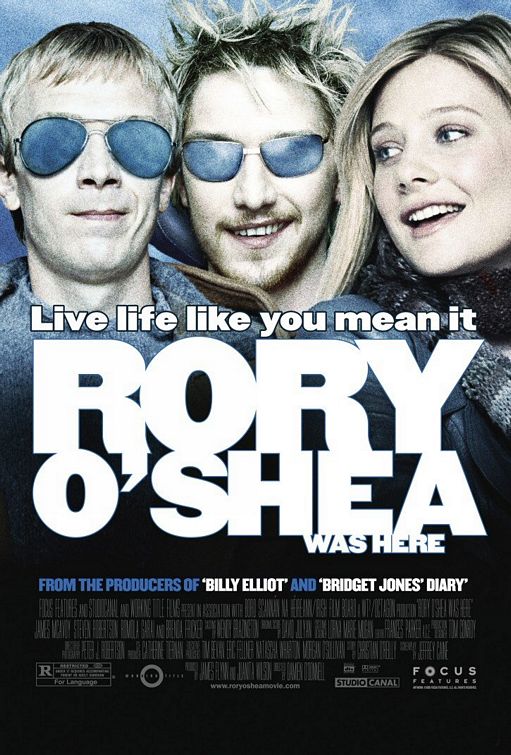"Discovering Human Dignity"

| None | Light | Moderate | Heavy | |
|---|---|---|---|---|
| Language | ||||
| Violence | ||||
| Sex | ||||
| Nudity |
What You Need To Know:
Steven Robertson is absolutely brilliant in this movie as Michael. He finds new ways of communicating emotion and thought. Although Rory’s independent, free-spirited character is more conventional, James McAvoy does a fine job interacting with Robertson. RORY O’SHEA WAS HERE is an excellent, ultimately worthwhile movie, but it requires extreme caution because of strong foul language, mature content and problematic themes. A Christian church service and a couple inspiring, dramatic speeches give a redemptive, uplifting, moral context to the story, however. Audiences will not easily forget these characters and their story.
Content:
(BB, C, RoRo, Pa, So, LLL, S, N, A, D, M) Strong, ultimately moral worldview with some positive Christian content, including a couple church services (one of which is very positive and heartwarming) and a reference to a Christian monk, as well as strong Romantic content about struggling against society’s rules and regulations, which favors individualism at the expense of responsibility, some immoral pagan, hedonistic behavior, and some implied socialist ideology; 39 mostly strong obscenities (mostly “f” words) and two strong profanities; brief sexual references to masturbation and women’s breasts, plus couples dance and disabled young man gets embarrassed when he gets aroused as young woman washes his body; upper male nudity and women are shown washing disabled men’s bodies but nothing salacious is seen though it is implied in one case; alcohol use and disabled men visit a bar and a nightclub; smoking; and, rebellious attitudes, jealousy and stealing from charity.
More Detail:
RORY O’SHEA WAS HERE is the first award-caliber movie to come out in 2005. Set in Ireland, it is a powerful, funny and touching portrayal of two young men whose bodies are bound to their wheelchairs, but whose spirits yearn to be free. Although it has some moral and philosophical problems, audiences will not easily forget these characters and their story.
The story opens in Dublin’s Carrigmore Home for the Disabled. All his life, Michael Connolly has lived in the residential care of the home. Michael has cerebral palsy, uses a motorized wheelchair, and has a significant speech impairment. Most people have difficulty hearing what he’s saving and simply stop trying to understand him.
Into the home, wheels 20-year-old Rory O’Shea. Suffering from muscular dystrophy, Rory only has the use of two fingers and partial movements of his head, but unlimited use of his mouth. Rory has known people like Michael, and he can understand them. He and Michael become fast friends, even though Michael realizes that Rory is a trouble-maker.
Rory is an angry, iconoclastic rules-breaker. He chafes at the lack of freedom that society has placed on disabled people like him. When the home uses the disabled people to ask for donations on the street, Rory masterminds a field trip to a pub and a nightclub with Michael. He then asks Michael to come with him to make an appeal for a personal-assistance grant so Rory can hire a personal assistant and live on his own. The board thinks Rory is too irresponsible to live on his own, even with a personal assistant. They turn down his request.
Inspired by Rory, Michael decides to make his own appeal for a grant. The board agrees, but they are surprised to learn that Michael is going to let Rory come with him, because Rory is the only person who understands and knows him. Michael and Rory recruit a pretty young woman named Siobhán (Shivawn) as their personal assistant. Their rivalry for her attention leads them to a new understanding of what being independent really means.
Steven Robertson is absolutely brilliant in this movie as Michael. He finds new ways of communicating emotion and thought, as Daniel Day Lewis did in his award-winning performance in MY LEFT FOOT. James McAvoy as Rory plays a more conventional character. Audiences have seen this kind of rebellious character in movies before. Even so, his interaction with Robertson helps make the story work, because it is their interaction that feeds the changes which take place in Michael’s character.
Rory’s iconoclastic, jealous character is very annoying at times. The movie at times seems to adopt Rory’s Romantic, independent struggle against society’s rules and regulations. In the end, however, Michael acknowledges that Rory can be a pain. In one important speech before the grant board, Michael tells them that rights exist independently of their exercise. He also tells them that disabled people like he and Rory should be allowed the freedom to make their own mistakes, so that they can learn from them. This Christian defense of human rights and human dignity is linked to an emotional church service that occurs at one crucial point in the movie.
In the end, therefore, the movie overcomes Rory’s boisterous, annoying character and Romantic worldview, including his use of foul language and an occasional crude sexual reference, with Christian love and understanding. Michael learns to love Rory like a brother and overlook Rory’s faults. Through Rory, Michael learns the true meaning of freedom, responsibility, dignity, and friendship. Still, the movie could use a stronger rebuke of Rory’s iconoclastic, Romantic attitude.
RORY O’SHEA WAS HERE is an excellent, ultimately worthwhile movie, but it requires extreme caution because of the crude language, mature content and problematic social themes. The Christian religious service toward the end provides a redemptive context for the story, however. Also important is a shot of a statue of St. Francis of Assisi and some spiritually uplifting music. Thus, the Romantic elements in the story are not used to attack Christianity or undermine its influence.



 - Content:
- Content: 


